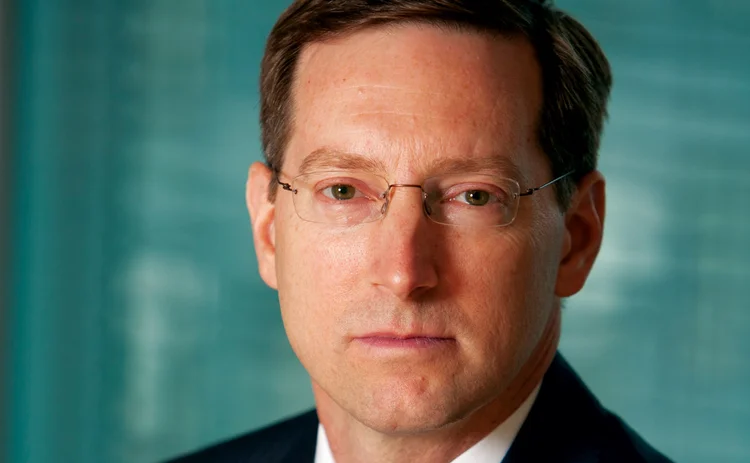
Derivatives house of the year: Citi
Energy Risk Awards 2017: Citi's multi-year strategy continues to pay off

With more than a touch of understatement, Citi’s global head of commodities Stuart Staley says “it has not always been easy” when discussing recent efforts to build out the bank’s commodities franchise. In addition to the global financial crisis and the swell of new regulations that were implemented in the aftermath, participants in the sector have faced challenging conditions across much of the commodities complex in recent years. By 2016, five years after the record peaks of 2011, prices in markets such as oil and metals had fallen by as much as 70%. In another trying development for derivatives providers, recent years have also seen the tail end of a lull in demand for hedging solutions due to this low price/low volatility environment.
It is well documented that many of the main financial firms pulled back sharply, or even exited, the commodities market in the wake of the global financial crisis, in response to the resulting regulatory pressures as well as falling margins in the commodities sector. In staying the course, Citi enhanced its position by picking up business from competitors that left the energy and metals space. By increasing its exposure to key commodities markets in this way and implementing a more capital-efficient, regulation-friendly approach suited to the post-crisis financial markets, Citi made strides past major market participants to become a top player in the commodities space in 2016. This forms part of the overall effort put in place by the group after the financial crisis to build on its market share across multiple product areas, according to Staley. “This has been a multi-year process for Citi, after emerging from the financial crisis in 2010,” he says. “Our universal aim as a bank has been to act as a multi-product provider, gaining as much market share among our target client base as possible by being able to provide the full range of products.”
Capital efficiencies
While Citigroup certainly experienced its own set of crisis-related woes, Staley argues that the bank has not only recovered, but has come back stronger, particularly in the commodities sector. “In a perverse way, we benefited from experiencing the crisis more severely and earlier than others in the market,” he says. “It forced us to be very parsimonious with capital and to focus on recycling capital – not necessarily holding and warehousing, but originating and distributing those risks and, therefore, the capital needs,” he continues, adding that focusing on the contribution of the marginal dollar employed and keeping costs lean “has held us in good stead.”
In a perverse way, we benefited from experiencing the crisis more severely and earlier than others in the market. It forced us to be parsimonious with capital and to focus on recycling capital
Stuart Staley, Citi
As such, Staley believes Citi has also benefited from the regulatory changes that have been implemented across global financial markets in recent years, particularly curbs on the private equity-type investments and balance sheet-intensive activity that once underpinned much of the activity of US banks in the commodities sector. “The regulators almost forced all banks to adopt a model that looked similar to the one we were already running,” he continues. “So we didn’t really have to change direction too much in relation to compliance – we simply continued to do more of what we were doing. I would say that other banks were probably more heavily affected by those changes because they had to dramatically divest certain assets or shut down activities.”
As one of the core financial participants that has remained active in the commodities market, Citi has reportedly picked up a number of trading books abandoned by those exiting the market, including from Credit Suisse and Deutsche Bank – the latter once a top-five player in the commodities sector. “The act of building out a commodities franchise designed to serve our client base has not been a straight line and it has not always been easy,” Staley says. “But it has been very successful in part because of the overlap between our existing franchise and the commodities space.”
Attracting new clients
As with most large financial organisations, one way to gain new business has been to attract clients from other parts of the bank, satisfying the commodity risk-management needs of firms with prior relationships elsewhere in the organisation. “With a banking franchise like Citi’s, which is very much emerging markets-oriented, commodity risks are coursing through it – whether that’s via corporate and sovereign entities looking to hedge, or investor clients that are seeking exposure to commodities,” Staley says. “So the commodities business is fundamentally important to the overall business model.”
Citi’s growth in the commodities space has allowed it to turn its traditional approach to building its franchise on its head, with cross-selling now working both ways. “What has been particularly powerful for us in terms of increasing our stature internally is that new clients often start their Citi relationship with the commodities business now, before becoming clients of other parts of the bank as well. So we have begun to differentiate ourselves internally, if you will, as a good source for cross-sell.”
The commodities clients that were interviewed by Energy Risk as part of the judging process called the bank a “top-tier liquidity provider”, with teams that are imaginative and responsive to problems and challenges due to an in-depth knowledge of the markets in which they operate. Commodity flow business from current clients also led to a number of large structured deals in 2016, enabling the bank to increase its footprint in that area. “Once you are out in the market and have onboarded these clients, you start getting the episodic deals that really contribute to the bottom line,” Staley says.
Power and metals
In the electricity markets, Citi participates in an average of about 30 structured trades annually, according to employees of its power business. In addition, an increased focus on renewable energy has lead to its involvement in cutting-edge transactions. A proxy revenue swap with global insurer Allianz in 2016, for example, saw the bank provide a fixed-price financial power swap to hedge the commodity price risk associated with a wind project located in the North American power markets. Mike Curry, head of structured origination and power sales in North America for Citi, believes the transaction represents “the next generation of structures” in the renewable energy space.
Citi has bolstered its presence in the power markets by providing large-volume, long-tenor transactions with producers and consumers for wind projects such as this, but also for other energy sources including gas-fired and combined-cycle generators. In addition to its growing structured trades offering, Citi saw volumes in its electricity flow sales business hit a peak of 130 million megawatt hours (MWh) in 2015, followed by a new high of 190 million MWh in 2016.
Citi’s precious metals business continued to see the benefit of a significant over-the-counter gold transaction with a central bank that was initiated in 2015, in terms of both ongoing contributions to its bottom line and its increased activity in that part of the market. In addition to increasing its activities in the central banking sector in recent years, the bank’s precious metals business has developed the ability to navigate “tricky” jurisdictions, providing hedging solutions in Indonesia and Russia last year, for example. Here again, the bank has picked up steam as competitors have exited the space in the aftermath of the global financial crisis. Citi’s head of metals, Rick McIntire, says the business has been able to step into the vacuum that has been left by this retrenchment, providing services that satisfy “the full continuum” of demand thanks in large part to Citi’s “global footprint and client reach”.
Staley also points to Citi’s well-established oil platform, which he says is a “significant contributor to the success of the business”. It attracts consumer clients, such as airlines and shipping companies, as well as producers from the exploration and production space and physical trading houses, all of whom require a wide range of hedging and financing solutions.
Citi’s precious metals business has developed the ability to navigate ‘tricky’ jurisdictions, providing hedging solutions in Indonesia and Russia last year
New ranking
These business areas made strong contributions to Citi’s commodities revenues in 2016. While the bank does not release a breakdown of revenues for its commodities operations, it says its global metals business contributed more than 40% of revenues in 2016, while the bank’s oil and power businesses made up much of the rest of the commodities revenues for last year. Such results have supported Citi’s rise through the ranks of the commodities sphere following the financial crisis. In terms of commodities revenues it moved from ninth place in 2012 to second in 2015, according to an industry league table produced by Standard & Poor’s-owned analytics firm Coalition. It remains one of the top three investment banks in the sector. Admittedly, competition has thinned in recent years, but major players such as Goldman Sachs and JP Morgan continue to operate formidable franchises in the commodities space, leaving Citi in good – and very competitive – company. While revenue growth would not warrant the title of Derivatives house of the year in and of itself, the increased strength of Citi’s capabilities across the commodities sector certainly does. In a year characterised by low prices and lacklustre activity in many sectors, Citi not only maintained a presence but continued to innovate across key global commodities markets.
Only users who have a paid subscription or are part of a corporate subscription are able to print or copy content.
To access these options, along with all other subscription benefits, please contact info@risk.net or view our subscription options here: http://subscriptions.risk.net/subscribe
You are currently unable to print this content. Please contact info@risk.net to find out more.
You are currently unable to copy this content. Please contact info@risk.net to find out more.
Copyright Infopro Digital Limited. All rights reserved.
As outlined in our terms and conditions, https://www.infopro-digital.com/terms-and-conditions/subscriptions/ (point 2.4), printing is limited to a single copy.
If you would like to purchase additional rights please email info@risk.net
Copyright Infopro Digital Limited. All rights reserved.
You may share this content using our article tools. As outlined in our terms and conditions, https://www.infopro-digital.com/terms-and-conditions/subscriptions/ (clause 2.4), an Authorised User may only make one copy of the materials for their own personal use. You must also comply with the restrictions in clause 2.5.
If you would like to purchase additional rights please email info@risk.net
More on Awards
Trading systems: structured products/cross-asset – Murex
Murex won the Trading systems: structured products/cross-asset award at the 2025 Risk Markets Technology Awards for its MX.3 platform, praised for its flexibility and advanced analytics
Best vendor for system support and implementation: Murex
Murex has won the Best vendor for system support and implementation at the Risk Markets Technology Awards, recognised for its innovative MX.3 platform, exceptional client support and seamless implementation services
FRTB-IMA product of the year: Murex
Murex wins FRTB-IMA product of the year for its advanced, scalable MX.3 platform enabling seamless regulatory compliance
Pricing and analytics: equities – Finastra
Finastra’s Sophis platform wins the Risk Markets Technology Award for Pricing and analytics in equities, recognised for its robust capabilities in equities and derivatives trading
Best execution product of the year: Tradefeedr
Tradefeedr won Best execution product of the year for its API platform, which standardises and streamlines FX trading data, enabling better performance analysis and collaboration across financial institutions
Collateral management and optimisation product of the year: LSEG Post Trade
LSEG Post Trade wins Collateral management and optimisation product of the year for interconnected services that help mitigate counterparty risk and optimise capital usage
Clearing house of the year: LCH
Risk Awards 2025: LCH outshines rivals in its commitment to innovation and co-operation with clearing members
Driving innovation in risk management and technology
ActiveViam secured three major wins at the Risk Markets Technology Awards 2025 through its commitment to innovation in risk management and technology







